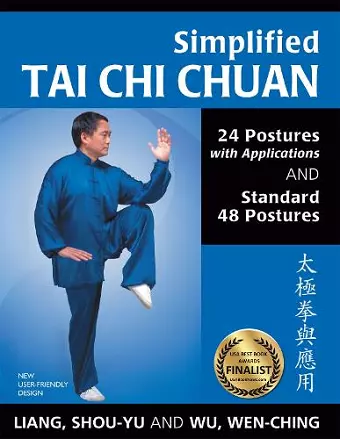Simplified Tai Chi Chuan
24 Postures with Applications & Standard 48 Postures
Shou-Yu Liang author Wen-Ching Wu author
Format:Paperback
Publisher:YMAA Publication Center
Published:15th May '14
Should be back in stock very soon

This guide offers a comprehensive introduction to Tai Chi, featuring popular sequences and clear instructions for effective practice. Simplified Tai Chi Chuan is perfect for beginners.
The book Simplified Tai Chi Chuan serves as an essential guide for beginners looking to delve into the art of Tai Chi. This revised edition features a modern layout that enhances the learning experience, showcasing each movement through 2-4 large photographs accompanied by clear instructions. The book introduces two widely practiced sequences: the Simplified 24 Posture Sequence, developed in 1956, and the Standard 48 Posture Sequence, created in 1976. These sequences are designed to cater to both beginners and intermediate practitioners, allowing for a gradual and comprehensive understanding of Tai Chi.
The Simplified 24 Posture Sequence is particularly noteworthy, as it was established by the Chinese Athletic Committee to promote Tai Chi globally. This form is characterized by its ease of learning and standardization based on the Yang style. Practitioners can expect to master this sequence in about 10 hours, and it can be performed in just 6 minutes, making it an ideal choice for those new to the practice. On the other hand, the 48 Posture Sequence combines elements from various styles, including Yang, Wu, Chen, and Sun, providing a rich experience for intermediate students.
In addition to the sequences, Simplified Tai Chi Chuan offers a comprehensive overview of Tai Chi's history, theoretical foundations, and practical guidelines. Readers will find detailed instructions for each posture, martial applications, and foot placement diagrams, all aimed at fostering a deeper understanding of this ancient practice. Whether you are a novice or looking to refine your skills, this book is a valuable resource for anyone interested in Tai Chi.
This guide successfully explains in clear language and visual imagery the basic concepts of this gentle martial art. The third edition of Simplified Tai Chi Chuan: 24 Postures with Applications and Standard 48 Postures gives detailed instruction about this health-enhancing exercise. Experienced martial arts practitioners and teachers, Shou-Yu Liang and Wen-Ching Wu write knowledgeably about two condensed forms of tai chi chuan intended for beginning and intermediate students. In 1956, the Chinese Sports Commission developed a twenty-four posture alternative to the Yang style long form to promote the practice of tai chi chuan. An expanded forty-eight movement sequence, compiled by the Chinese National Athletic Association in 1976, incorporates postures from Yang, Chen, Wu, and Sun styles. Some fast movements included in that sequence "characteristic of martial arts power emission called fajin" offer students new challenges. Both sequences emphasize the rewards that come with consistent practice. An introductory narrative reviews the history and theory behind the five principal styles of tai chi and explains the body movements, awareness of breath, and coordination of mind with internal energy that are basic to the practice. The authors write in a straightforward style that establishes the clear focus necessary for learning this ancient art. Because Chinese pinyin words and phrases used in the book may be unfamiliar to novices, Liang and Wu provide English equivalents, in parentheses, after each pinyin word. These terms include, for example, "taijiquan (tai chi chuan)," "qi (chi)," "dan tian (dan dien)," and "qigong (chi kung)." An appendix lists the names of postures in sequential order for the twenty-four and forty-eight movement forms. A glossary of Chinese words provides further clarification. According to the authors, tai chi postures evolved in imitation of animal behavior and other aspects of nature. The English translations of these names offer visual reminders to students as they learn to execute the movements. Names such as "White Crane Spreads Its Wings," "Wild Horse Parts Its Mane," and "Needle at Sea Bottom" are followed by parenthesized pinyin phrases. Photographs show a man performing each posture, with directional arrows indicating his foot and hand movements. Charts and graphs offer additional visual help and complement the book's explanatory text. Martial arts applications for the twenty-four posture form follow a similar format. In the photos, two participants wear white and gray jackets to distinguish their defensive or offensive positions. These explanations are not included for the forty-eight posture sequence. The book ends abruptly with that form's closing posture, a minor flaw in this otherwise professionally astute work. As an instructional book, Simplified Tai Chi Chuan successfully explains in clear language and visual imagery the basic concepts of this gentle martial art. Tai chi chuan is traditionally practiced in groups, often in the company of a leader or teacher. Learning these simplified forms on one's own requires considerable patience and commitment. Nevertheless, those wanting to undertake this challenge will find helpful knowledge and encouragement in the book. Others interested in learning the history and theory of this fascinating martial art will be well served. -- Margaret Cullison, This guide offers excellent instruction for those who wish to know more about this internal martial art. Foreword Reviews, October 16, 2014
- Runner-up for USA Best Books Award 2015 (United States)
ISBN: 9781594392788
Dimensions: unknown
Weight: 667g
336 pages
2nd New edition